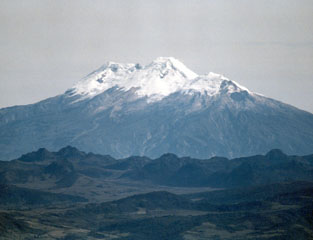Report on Nevado del Huila (Colombia) — 4 November-10 November 2009
Smithsonian Institution / US Geological Survey
Weekly Volcanic Activity Report, 4 November-10 November 2009
Managing Editor: Sally Sennert.
Please cite this report as:
Global Volcanism Program, 2009. Report on Nevado del Huila (Colombia) (Sennert, S, ed.). Weekly Volcanic Activity Report, 4 November-10 November 2009. Smithsonian Institution and US Geological Survey.
Nevado del Huila
Colombia
2.93°N, 76.03°W; summit elev. 5364 m
All times are local (unless otherwise noted)
INGEOMINAS reported that overflights of Nevado del Huila on 4, 6, and 10 November revealed a continued high rate of lava dome growth; the volume estimate for the new lava dome was nearly 25 million cubic meters. Small collapses occurred on the W part of the dome. Gas emissions were sometimes accompanied by pulsating ash emissions. Sulfur dioxide plumes rose 2.5 km above the lava dome and were seen in satellite imagery and the web camera drifting with the prevailing winds. The Alert Level remained at II (Orange; "probable eruption in term of days or weeks").
Based on analyses of satellite imagery, the Washington VAAC reported that during 4-6 and 10 November thermal anomalies on the volcano were seen intermittently through cloud cover. On 7 November, Bogota MWO reported an ash plume at an altitude of 9.4 km (31,000 ft) a.s.l., and a plume was seen drifting ESE on satellite imagery. Later that day, an ash plume was seen on satellite imagery and on the web cameras drifting SE at an altitude below 7.3 km (24,000 ft) a.s.l.
Geological Summary. Nevado del Huila, the highest peak in the Colombian Andes, is an elongated N-S-trending volcanic chain mantled by a glacier icecap. The andesitic-dacitic volcano was constructed within a 10-km-wide caldera. Volcanism at Nevado del Huila has produced six volcanic cones whose ages in general migrated from south to north. The high point of the complex is Pico Central. Two glacier-free lava domes lie at the southern end of the volcanic complex. The first historical activity was an explosive eruption in the mid-16th century. Long-term, persistent steam columns had risen from Pico Central prior to the next eruption in 2007, when explosive activity was accompanied by damaging mudflows.
Sources: Washington Volcanic Ash Advisory Center (VAAC), Servicio Geológico Colombiano (SGC)

